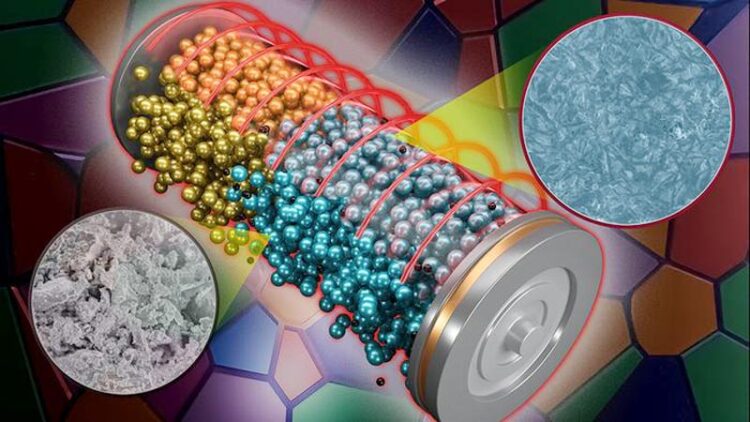Turning up the heat

ORNL researchers have developed a new pressing method, shown as blue circle on right, that produces a more uniform solid electrolyte than the traditionally processed material with more voids, shown as gray circle on left. The material can be integrated into a battery system, center, for improved stability and rate performance.
Credit: Andy Sproles/ORNL, U.S. Dept. of Energy
Small change brings big gain in performance for solid-state battery electrolyte.
Oak Ridge National Laboratory scientists found that a small tweak created big performance improvements in a type of solid-state battery, a technology considered vital to broader electric vehicle adoption.
These batteries use a solid electrolyte instead of a potentially flammable liquid. When the battery charges or operates, ions move between electrodes through the electrolyte between them. A new method for pressing the solid electrolyte practically eliminates tiny air pockets that block ion flow, so the battery charges twice as fast.
ORNL lead researcher Marm Dixit said the approach involved heating the press after spreading the electrolyte on it, then letting the electrolyte cool under pressure. The resulting material was almost 1,000 times more conductive. “It’s the same material — you’re just changing how you make it, while improving the battery performance on a number of fronts,” Dixit said.
These results demonstrate a pathway for processing solid electrolytes at an industrial scale while providing unprecedented control over their internal structure for a more reliable battery.
Journal: ACS Energy Letters
DOI: 10.1021/acsenergylett.3c00265
Article Title: Tailoring of the Anti-Perovskite Solid Electrolytes at the Grain-Scale
Article Publication Date: 21-Apr-2023
Media Contact
Alexandra DeMarco
DOE/Oak Ridge National Laboratory
demarcoag@ornl.gov
Office: 615-935-1044
Original Source
All latest news from the category: Power and Electrical Engineering
This topic covers issues related to energy generation, conversion, transportation and consumption and how the industry is addressing the challenge of energy efficiency in general.
innovations-report provides in-depth and informative reports and articles on subjects ranging from wind energy, fuel cell technology, solar energy, geothermal energy, petroleum, gas, nuclear engineering, alternative energy and energy efficiency to fusion, hydrogen and superconductor technologies.
Newest articles

Parallel Paths: Understanding Malaria Resistance in Chimpanzees and Humans
The closest relatives of humans adapt genetically to habitats and infections Survival of the Fittest: Genetic Adaptations Uncovered in Chimpanzees Görlitz, 10.01.2025. Chimpanzees have genetic adaptations that help them survive…

You are What You Eat—Stanford Study Links Fiber to Anti-Cancer Gene Modulation
The Fiber Gap: A Growing Concern in American Diets Fiber is well known to be an important part of a healthy diet, yet less than 10% of Americans eat the minimum recommended…

Trust Your Gut—RNA-Protein Discovery for Better Immunity
HIRI researchers uncover control mechanisms of polysaccharide utilization in Bacteroides thetaiotaomicron. Researchers at the Helmholtz Institute for RNA-based Infection Research (HIRI) and the Julius-Maximilians-Universität (JMU) in Würzburg have identified a…



